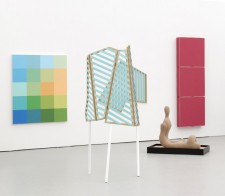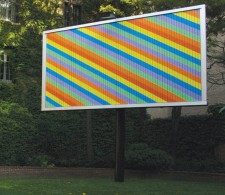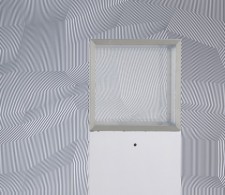Harley Parker was born in Thunder Bay (then Fort William), Canada in 1915 and spent his youth there, graduating from high school and then in a compressed one-year degree from a local technical institute. He studied at Ontario College of Art (OCA), where he excelled, graduating in 1939, and between 1940-42 he took up posts at Cooper and Beatty and T. Eaton and Co. in Toronto as a typographic designer. His typographic skills and experimental style would prove to be dazzling, to which two of his later collaborations with Marshall McLuhan would attest, first in the guise of Explorations 8 (Verbi-Voco-Visual Explorations) (1957), and later in the book Counterblast (1969). After serving in the Canadian military from 1942-45 where he was Sergeant Instructor to the Camouflage Wing, he returned to take up a teaching post at OCA where he remained until 1957 when he joined the Royal Ontario Museum (ROM). During his second year back at OCA he pursued a post-graduate course at the Summer Arts Institute of Black Mountain College in Asheville, North Carolina. That year (1946) Bauhaus professor Josef Albers taught color theory and Parker took his class. Parker’s career as Head of Exhibit Design at the ROM lasted until June 30th, 1968, after completing most of a year-long leave of absence. The ROM’s employee card put the matter dryly: “Did not return.” During his leave Parker accompanied McLuhan to Fordham University where he took the post of Associate Professor in the Albert Schweitzer Program, during McLuhan’s year there as a research chair. Parker would later occupy the first William A. Kern Chair in Communications at the Rochester Institute of Technology (1973).
The story of Parker’s career is not well known, despite his much publicized collaborations with McLuhan in books (co-authoring Through the Vanishing Point, 1968), films (Picnic in Space, 1967), and events like the seminar on Museum Communication at the Museum of the City of New York (1967). This special issue of Amodern – the second of my Parker-focused activities following upon the 2012 seminar in Oshawa, Harley Parker and Challenge to Curatorial Authority, during which several of the papers published here were first presented – will contribute to filling in the gaps and consolidating Parker’s considerable accomplishments. Parker remains an enigma in part due to his status, first, as a problem-solving installation designer within a university museum that valued curation over design, and second, as a celebrated designer operating in the shadow of a major public intellectual, McLuhan; at worst, this position can be summed up by those newspapers wags who simply said he was “fronting” for McLuhan. The essays in this special issue reveal that Parker authored numerous articles on design and perception, and appeared regularly in the Toronto newspapers as a jack-of-all-trades prepared to speak on art, society, technology, and architecture.










